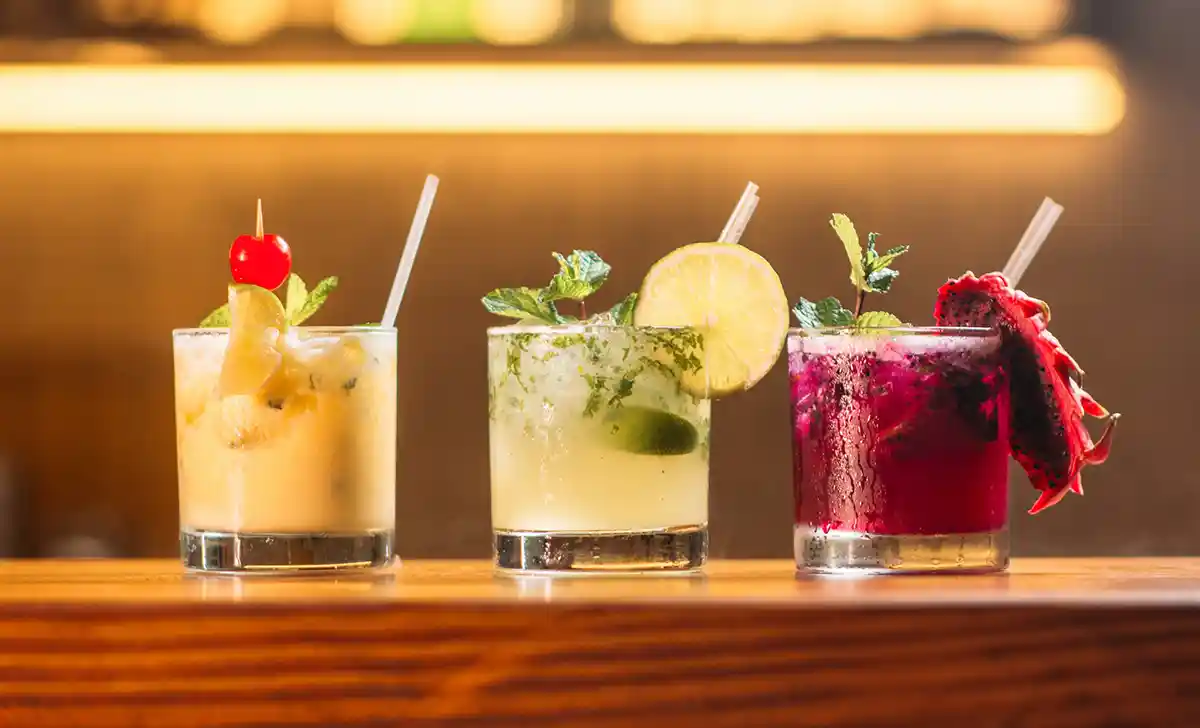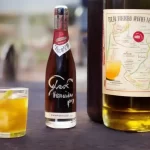The History of Cocktails
Cocktails have a rich and fascinating history that dates back to the early 19th century. The first definition of a cocktail appeared in a New York newspaper in 1806, which described it as “a stimulating liquor composed of spirits of any kind, sugar, water, and bitters.” Since then, cocktails have evolved into a diverse and creative genre of drinks that reflect different cultures, traditions, and trends.
The golden age of cocktails was in the 1920s and 1930s, when prohibition led to a boom in speakeasies and underground drinking culture. During this era, bartenders like Harry Craddock and Jerry Thomas invented many classic cocktails such as the Martini, Manhattan, and Daiquiri. These drinks became symbols of sophistication, luxury, and rebellion.
In the mid-20th century, cocktails lost some of their allure due to the rise of beer and wine consumption and the decline of cocktail culture in America. However, in the 1980s and 1990s, cocktails made a comeback, thanks to the revival of classic recipes and the emergence of new trends and techniques. Today, cocktails are more popular than ever, and bartending has become a respected and creative profession.
The Basics of Mixing Cocktails
Mixing cocktails is both an art and a science that requires precision, creativity, and attention to detail. Here are some of the basic tools, ingredients, and techniques that every bartender should know.
Tools and Ingredients
To make cocktails, you will need a set of basic tools, including a shaker, a jigger, a strainer, a muddler, a bar spoon, and a citrus press. You will also need a range of ingredients, such as spirits (e.g., gin, vodka, whiskey, tequila), mixers (e.g., juice, soda, tonic, syrup), and garnishes (e.g., citrus, herbs, spices).
Techniques
Mixing cocktails involves several techniques, such as shaking, stirring, muddling, and layering. Shaking is used for cocktails that contain citrus or other juices and require a frothy texture, while stirring is used for cocktails that are all spirits and need a smoother and clearer texture. Muddling is used for releasing the flavors of herbs or fruits, while layering is used for creating visually stunning drinks with different densities.
Glassware
The choice of glass
The Art of Balancing Flavors
Mixing cocktails is not just about combining ingredients; it’s also about creating a balanced and harmonious flavor profile that pleases the palate. Here are some of the key elements of flavor balancing in cocktails.
Sweetness and Sourness
Sweetness and sourness are two of the most important flavor components in cocktails. Sweetness can come from sugar, honey, or syrups, while sourness can come from citrus juices, vinegar, or bitters. A good cocktail should have a balanced ratio of sweetness and sourness, depending on the recipe and the taste preferences of the drinker.
Bitterness and Alcohol Content
Bitterness is another flavor component that can add complexity and depth to cocktails. Bitters are usually made from herbs, roots, or bark, and can be used in small amounts to balance the sweetness and acidity of a drink. Alcohol content is also a crucial factor in cocktail balance, as it can affect the intensity and complexity of the flavor profile. Different spirits have different levels of alcohol content, which can be adjusted according to the recipe and the desired effect.
Aromatics and Garnishes
Aromatics and garnishes are the final touches that can elevate a cocktail from good to great. Aromatics can come from herbs, spices, or fruits, and can be added to the drink or used as a garnish. Garnishes can be simple, such as a citrus twist or a cherry, or elaborate, such as a flaming piece of cinnamon or a skewered fruit kebab. Aromatics and garnishes can add visual appeal, aroma, and complexity to a cocktail, and can also reflect the theme or season of the drink.
Popular Cocktails and Recipes
Cocktails come in a variety of styles, flavors, and colors, and can be adapted to different occasions and preferences. Here are some of the most popular and classic cocktails, along with their recipes and variations.
Classic Cocktails
Martini: gin or vodka, dry vermouth, olive or twist
Manhattan: whiskey, sweet vermouth, bitters, cherry
Old Fashioned: whiskey, sugar, bitters, orange, cherry
Daiquiri: rum, lime juice, sugar, shaken and strained
Margarita: tequila, lime juice, triple sec, salt rim
Modern Cocktails
Cosmopolitan: vodka, cranberry juice, triple sec, lime juice
Mojito: rum, mint, lime juice, sugar, soda water
Espresso Martini: vodka, espresso, coffee liqueur, sugar syrup
Negroni: gin, Campari, sweet vermouth, orange twist
Aperol Spritz: Aperol, Prosecco, soda water, orange slice
Cocktail Trends and Innovations
Cocktail culture is constantly evolving, and new trends and innovations are emerging all the time. Here are some of the latest developments in the world of cocktails.
Molecular mixology is a cutting-edge approach to cocktail making that involves using scientific techniques and tools to create unique textures, flavors, and presentations. Techniques such as spherification, foaming, and smoking can transform familiar ingredients into innovative and surprising cocktails.
Local and Seasonal Ingredients
The use of local and seasonal ingredients has become a popular trend in cocktail making, as it allows bartenders to showcase the flavors and traditions of their region. Using fresh herbs, fruits, and vegetables can also add complexity and depth to cocktails, and create a connection between the drink and the environment.
Low- and No-Alcohol Cocktails
As more people are becoming health-conscious and seeking alternative options, low- and no-alcohol cocktails have become a trend in the cocktail world. These drinks can still offer complex and interesting flavors, without the high alcohol content. Ingredients such as shrubs, bitters, and syrups can add depth and complexity to the drink, while sparkling water or non-alcoholic spirits can replace the alcohol.
The Role of Cocktails in Socializing
Cocktails have always played a central role in socializing and celebrations, from happy hour to weddings to New Year’s Eve parties. Here are some of the ways cocktails are used in different social contexts.
Happy Hour and Networking
Happy hour is a time-honored tradition of gathering with friends or colleagues after work, and enjoying some drinks and snacks. Cocktails can help to break the ice and create a relaxed and convivial atmosphere, which can facilitate networking and socializing.
Date Night and Romantic Drinks
Cocktails can also be used to create a romantic and intimate setting for a date night or a special occasion. Drinks such as the Champagne cocktail or the French 75 can add a touch of elegance and sophistication, while fruity and floral cocktails can be used to evoke feelings of passion and sensuality.
Special Occasions and Celebration Drinks
Cocktails are often used to mark special occasions, such as weddings, birthdays, or graduations. These drinks can be customized to reflect the theme or mood of the celebration, and can be served in creative and festive ways, such as in a punch bowl or a flaming volcano.
Conclusion
Cocktails are not just drinks; they are works of art that reflect the creativity, skill, and passion of the bartender. Whether you prefer classic recipes or innovative techniques, there is a cocktail for every occasion and taste. So next time you order a drink, take a moment to appreciate the art and science of mixing cocktails, and savor every sip.
FAQs
What are some popular cocktails for beginners?
Some popular cocktails for beginners include the Margarita, the Daiquiri, and the Mojito.
What are some tips for making cocktails at home?
Some tips for making cocktails at home include using fresh and quality ingredients, measuring accurately, and experimenting with different ratios and techniques.
What is the difference between a shaken and a stirred cocktail?
A shaken cocktail is typically served cold and frothy, while a stirred cocktail is served smooth and clear.
How do I choose the right glassware for a cocktail?
The choice of glassware depends on the type and style of the cocktail, as well as the occasion and setting. Generally, a cocktail should be served in a glass that enhances its aroma, appearance, and flavor.
Are there any health benefits to drinking cocktails?
While excessive drinking can have negative health effects, moderate consumption of cocktails has been associated with some health benefits, such as reducing the risk of heart disease and diabetes. However, it’s important to drink responsibly and in moderation.



